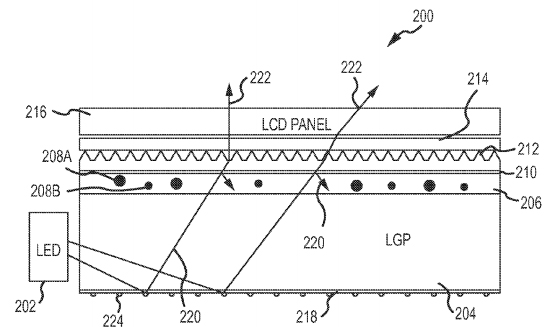
The patent describes quantum dots as being similar in shape to traditional nanocrystals found in regular displays, but can also change sizes in order to emit light of different colors more effectively. For instance, bigger quantum dots can emit a longer wavelength light color such as red, while small quantum dots can emit shorter wavelength light should as blue light or violet light. This results in the quantum dots being able to cover a wider and more varied color spectrum compared to current LEDs, which can only emit light in a fixed spectrum.
As one example, Quantum dots (QDs) are semiconductors in the form of nanocrystals that provide an alternative display. The electronic characteristics of the QDs are generally governed by the size and shape of the nanocrystals. Quantum dots of the same material, but with different sizes, can emit light of different colors when excited. More specifically, the emission wavelength of the QDs varies with a size and shape of the quantum dots. As one example, larger dots may emit longer wavelength light, such as red light while smaller QDs may emit shorter wavelength light, such as blue light or violet light.Apple goes on to note that one of the issues with quantum dots is the toxic nature of their contents, going on to suggest that cadmium-free quantum dots or heavy metal-free quantum dots could be used in order to alleviate the problem. The patent also suggests that there "remains a need" for designing the quantum-dot enhanced display to achieve more breakthroughs before it becomes ready for general use, including reduced toxicity, improved performance, and lower cost in fabrication.
Meanwhile, the dichroic filter that would be deployed on the quantum dot display would help reduce the density and toxic content of the quantum dots, and would also improve color and luminance levels, resulting in a more vibrant and accurate display. The filter itself would help in transmitting red light and a green light while reflecting most of a blue light, so that white light can be produced and ultimately benefit color accuracy as a whole.
It is not known exactly if or when Apple plans to integrate quantum dot enhanced displays in its products, but the company would have incentive to do so given criticisms of the Retina iPad mini display compared to Google's and Amazon's 7-inch tablets. Beyond mobile devices, quantum dot displays may also make their way to notebook computers, televisions and other consumer electronics over time.
Thursday December 19, 2013 7:17 am PST by Richard Padilla - macrumors.com
No comments:
Post a Comment